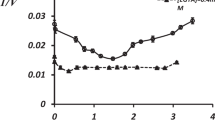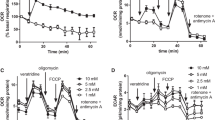Abstract
The effects of phenylalanine (PHE) and its deaminated metabolites phenylpyruvate (PHP), phenyllactate (PHL) and phenylacetate (PHA) on sodium and potassium activated adenosinetriphosphatase (Na+, K+-ATPase) in synaptosomes from rat brain were investigated. At very low concentrations (5–10 μM), PHE, PHL and PHA inhibited the activity, while PHP stimulated the activity. At intermediate concentrations (50–100 μM), all compounds had no effect, but at higher (0.5–1.0 mM) concentrations they inhibited the enzyme activity. Thus all the compounds tested showed a biphasic effect on the enzyme activity. Hydroxylamine inhibited the Na+, K+-ATPase activity when present alone; simultaneous addition of hydroxylamine and PHE, however, eliminated the inhibitory effects of each other. Reversal of mutual inhibition also occurred in the presence of hydroxylamine and very low (5–10 μM) concentrations of PHL or PHA. The inhibitory effects of PHE at all concentrations, and of PHL or PHA at low concentrations, were also eliminated in the presence of EGTA. The data indicate that inhibition of brain membrane Na+, K+-ATPase by PHE and by low concentrations of PHL and PHA may involve metal ions, but that the inhibition by high concentrations of these metabolites must occur by a different mechanism. Since Na+, K+-ATPase plays a central role in neuronal function, and the presence of excess PHE and its deaminated metabolites occurs in brain tissue under conditions of experimentally induced hyperphenylalaninemia and genetic phenylketonuria, the neurologic impairment in experimental and genetic PKU may in part be related to the deleterious effects of these compounds on brain ATPase.
Similar content being viewed by others
References
Abdel-Latif, A., Brody, J., andRamahi, H., 1967. Studies on sodium-potassium adenosine triphosphatase on the nerve endings and appearance of electrical activity in developing rat brain, J. Neurochem. 14:1113–1141.
Bader, H., Wilkes, A. B., andJean, D. M., 1970 The effect of hydroxylamine, mercaptans, divalent metals and chelators on Na+, K+-ATPase: A possible mechanism. Biochim. Biophys. Acta 198:583–593.
Chalmers, R. A., andWatts, R. W. E., 1974. Quantitative studies on the urinary excretion of unconjugated aromatic acids in phenylketonuria. Clin. Chim. Acta 55:281–294.
Dwivedy, A. K., andShah, S. N., 1981. Effect of experimental hyperphenylalaninemia on Na++K+-ATPase in rat brain. Exptl. Neurol. 74:924–929.
Edwards, J. D., andBlau, K., 1972. Aromatic acids derived from phenylalanine in the tissues of rats with experimentally induced phenylketonuria like characteristics. Biochem. J. 130:495–503.
Gallaghar, B. B., 1969. The effect of phenylpyruvate on oxidative phosphorylation in brain mitochondria. J. Neurochem. 16:1071–1076.
Glynn, I. M., 1968. Membrane adenosine triphosphatase and cation transport. Br. Med. Bull. 24:165–169.
Iverson, L. L., andKelly, J. S., 1975. Uptake and metabolism of γ-aminobutyric acid by neurons and glial cells. Biochem. Pharmacol. 24:933–938.
Loo, Y. H., Scotto, L., andHorning, M. G., 1976. Gas chromatographic determination of aromatic acid metabolites of phenylalanine in brain. Anal. Biochem. 76:111–118.
Schaefer, A., Komlos, M., andSeregi, A., 1979. Studies on the effect of catecholamines and chelating agents on the synaptic membrane Na+, K+-ATPase activity in the presence and absence of hydroxylamine. Biochem. Pharmacol. 28:2307–2312.
Specht, S., andRobinson, J. D., 1973. Stimulation of the (Na++K+)-dependent adenosine triphosphatase by amino acids and phosphatidylserine: Chelation of trace metal inhibitors. Arch. Biochem. and Biophys. 154:314–323.
Ting-Beall, H. P., andWells, W. W., 1971. Effect of calcium chelation by phenylalanine on (Na++K+)-stimulated ATPase of chick brain microsomes. FEBS Letters 16:352–354.
Verity, M. A., 1972. Cation modulation of synaptosomal respiration. J. Neurochem. 19:1305–1317.
Wallick, E. T., Allen, J. C., andSchwartz, A., 1973. Differential effects of metal chelators on Na+, K+-ATPase activity. Arch. Biochem. and Biophys. 158:149–153.
Whittam, R., 1961. Active cation transport as a pace-maker of respiration. Nature, Lond. 191:603–604.
Zelnicek, E., andPoddhradsku, O., 1969. Clearance of endogenous phenylpyruvate in phenylketonuria. Clin. Chim. Acta 25:174–180.
Author information
Authors and Affiliations
Rights and permissions
About this article
Cite this article
Dwivedy, A.K., Shah, S.N. Effects of phenylalanine and its deaminated metabolites on Na+, K+-ATPase activity in synaptosomes from rat brain. Neurochem Res 7, 717–725 (1982). https://doi.org/10.1007/BF00965524
Accepted:
Issue Date:
DOI: https://doi.org/10.1007/BF00965524




